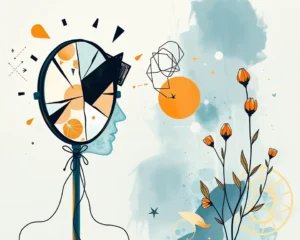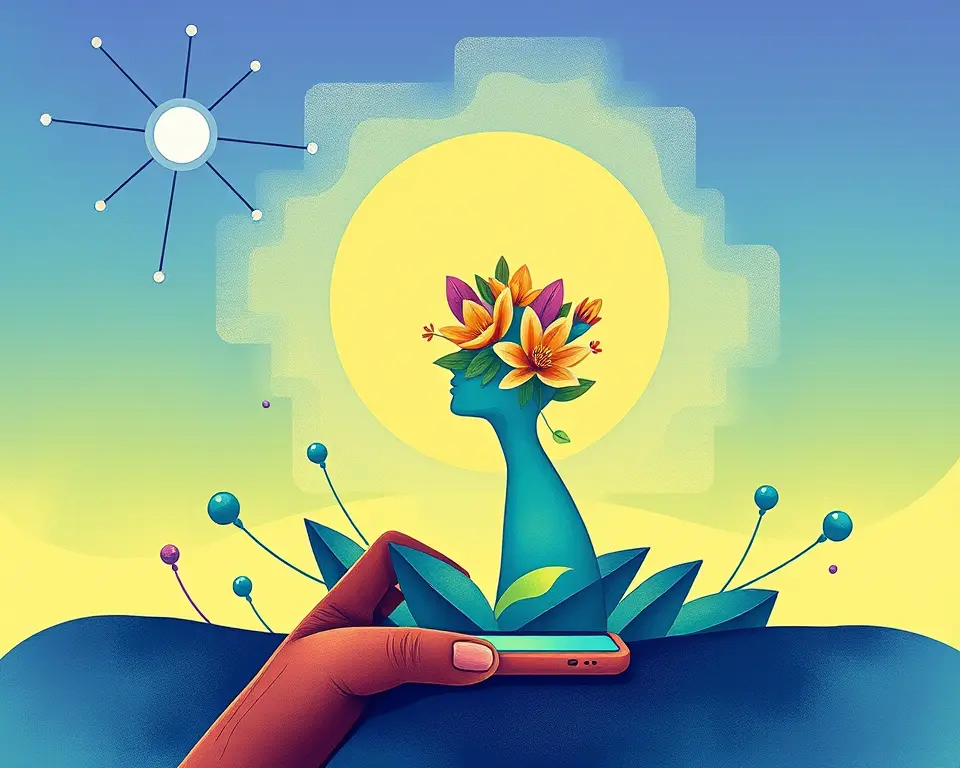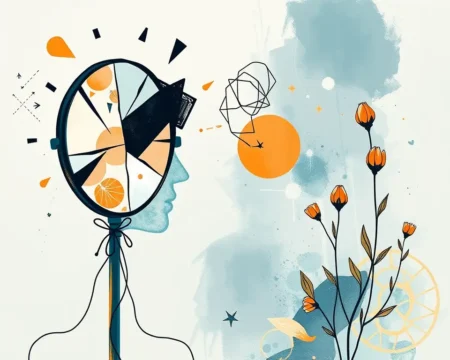The intersection of technology and mental health is rapidly evolving, with self-guided mental health apps emerging as a potentially transformative force. These apps offer a readily accessible and often affordable means of supporting mental well-being. Recent research suggests that these digital tools can indeed improve mental health outcomes and lower costs, presenting a compelling case for their integration into the broader mental healthcare landscape. This article explores the benefits, challenges, and future directions of self-guided mental health apps.
The Rise of Self-Guided Mental Health Apps
In recent years, there has been a significant increase in the development and adoption of mental health apps. As of 2017, there were at least 325,000 mental health apps on the market, addressing a wide range of needs from general mental wellness to specific conditions such as depression, anxiety, and bipolar disorder. This surge in popularity is driven by several factors, including increased accessibility, reduced stigma, and the convenience of on-demand support.
What are Self-Guided Mental Health Apps?
Self-guided mental health apps are designed to provide users with tools and resources to manage their mental health independently. These apps utilize various techniques and approaches, including:
- Mood Tracking and Emotion Detection: Algorithms process user input (text, speech, or physiological data) to detect emotional states and identify mood patterns over time.
- Guided Activities: These include tracking, relaxation, and meditation exercises.
- Cognitive Behavioral Therapy (CBT) Modules: Delivering CBT techniques through structured programs.
- Mindfulness and Meditation: Focus on present moment awareness and clearing the mind.
- Relaxation Techniques: Deep breathing exercises and calming music.
- Information and Advice: Providing educational content on mental health topics.
- Goal Setting: Helping users set and achieve mental wellness goals.
Why are Self-Guided Apps Gaining Traction?
Several key advantages contribute to the growing popularity of self-guided mental health apps:
- Accessibility: Apps eliminate geographical, economic, and logistical barriers to care, making them particularly valuable in low-resource settings or rural areas.
- Affordability: Many apps are free or low-cost, making mental health support more accessible to a broader population.
- Convenience: Unlike traditional services, apps offer continuous, on-demand support.
- Anonymity and Privacy: AI-based tools can reduce the stigma associated with seeking help, especially among those hesitant to access traditional services.
- Timely Support: Users can access support directly when needed, overcoming long waiting lists and limited therapist availability.
The Benefits: Improved Outcomes and Lower Costs
The potential of self-guided mental health apps to improve outcomes and lower costs is supported by a growing body of research. Studies have shown that these apps can lead to:
Enhanced Patient Empowerment
Self-guided apps can contribute to lasting improvements in patient empowerment by enhancing mental health literacy, self-management skills, and help-seeking behaviors. By providing users with the knowledge and tools to manage their mental health, these apps foster a sense of control and agency.
Symptom Reduction
Several studies have demonstrated that mental health apps can effectively reduce symptoms of various mental health conditions. For example, the Woebot app, which utilizes CBT-derived self-help interventions, has been shown to reduce symptoms of depression among college students within two weeks of use. Similarly, the Youper app has demonstrated moderate reductions in anxiety and depression in a longitudinal study involving over 4,500 users.
Improved Quality of Life
In addition to symptom reduction, mental health apps have been shown to improve overall quality of life. A study on a self-guided transdiagnostic app (MindDoc) found that symptoms of common mental disorders and quality of life improved faster in the intervention group than in the control group.
Cost-Effectiveness
Self-guided mental health apps offer a cost-effective alternative to traditional therapy. By reducing the need for in-person visits and minimizing the demand on healthcare resources, these apps can significantly lower the overall cost of mental healthcare. This is particularly important in addressing the global mental health crisis, where resources are often limited.
Support Treatment Seeking
Self-guided mental health apps can support treatment seeking by reducing barriers and facilitating mental health literacy. Digital interventions can improve self-management skills, contributing to symptom reduction and improved quality of life.
Challenges and Pitfalls
Despite their numerous benefits, self-guided mental health apps also present several challenges and potential pitfalls that must be addressed to ensure their safe and effective use.
Lack of Clinical Validation
One of the most significant concerns is the lack of clinical validation for many available apps. With thousands of mental health apps on the market, only a fraction have been rigorously tested and proven effective. This raises questions about the reliability and safety of these tools, as some may offer limited or even harmful advice.
Privacy and Data Security
The use of AI in mental health introduces significant privacy and ethical risks. Many apps collect highly sensitive user information but lack robust data protection measures. Transparency in data usage and third-party sharing remains inadequate in most cases. Users must be aware of how their data is being collected, stored, and used, and they should have control over their personal information.
Algorithmic Bias
AI-based mental health apps also pose the problem of algorithmic bias. AI systems trained on non-representative datasets have a high risk of perpetuating biases, leading to culturally inappropriate responses or inequitable access to care. It is crucial to ensure that these apps are developed and trained using diverse and representative data to avoid exacerbating existing inequalities.
Digital Dependency
The engagement-driven strategies used by some mental health apps, mirroring those in social media, risk prioritizing user retention over genuine therapeutic benefit. These features can foster compulsive digital behaviors that undermine self-regulation and blur the line between mental health support and digital dependency. Users may conflate app engagement with substantive psychological progress, reinforcing cyclical usage with limited therapeutic benefit.
Over-Reliance and Delayed Treatment
While offering tools like self-guided meditation, CBT modules, and AI-driven chatbots, the indiscriminate adoption of these apps risks fostering over-reliance, dissuading individuals from pursuing professional mental health intervention, and delaying the initiation of evidence-based treatment. This misplaced confidence in self-guided digital tools can delay necessary clinical treatment, exacerbating underlying conditions and reducing the likelihood of successful therapeutic outcomes.
User Engagement and Attrition
Maintaining user engagement is a significant challenge for mental health apps. Studies have shown that many users discontinue using apps after a short period, limiting their potential benefits. Factors such as lower age and higher personality dysfunction have been identified as predictors of attrition.
Maximizing the Benefits and Minimizing the Risks
To harness the full potential of self-guided mental health apps while mitigating the associated risks, several steps must be taken:
Clinical Validation and Regulation
There is a critical need for more rigorous clinical validation of mental health apps. Regulatory bodies should establish clear standards and guidelines for app development and evaluation to ensure that these tools are safe, effective, and evidence-based. Apps that meet these standards should be clearly identified to help users make informed choices.
Protecting User Privacy
Robust data protection measures must be implemented to safeguard user privacy and security. App developers should be transparent about data collection and usage practices, and users should have control over their personal information. Compliance with data privacy regulations, such as GDPR and HIPAA, is essential.
Addressing Algorithmic Bias
Efforts must be made to address algorithmic bias in AI-based mental health apps. This includes using diverse and representative data to train AI systems, regularly auditing algorithms for bias, and implementing mechanisms to ensure equitable access to care.
Promoting Responsible Use
Users should be educated about the potential risks and limitations of self-guided mental health apps. It is important to emphasize that these apps are not a substitute for professional mental healthcare and that individuals should seek help from a qualified mental health professional when needed.
Enhancing User Engagement
App developers should focus on enhancing user engagement by creating personalized and interactive experiences. Gamification, social support features, and regular reminders can help keep users motivated and engaged over time.
Integration with Traditional Care
Mental health apps can be most effective when integrated with traditional mental healthcare. These apps can complement in-person therapy by tracking moods, reinforcing interventions, and enhancing patient engagement between sessions.
The Future of Self-Guided Mental Health Apps
The future of self-guided mental health apps is promising, with ongoing advancements in technology and a growing recognition of their potential to transform mental healthcare. As AI and machine learning continue to evolve, these apps will become even more personalized, adaptive, and effective.
Personalized Interventions
AI-powered apps can analyze user data to provide personalized interventions tailored to individual needs and preferences. This includes customizing content, adjusting the difficulty of exercises, and providing targeted feedback.
Predictive Analytics
By analyzing user data, mental health apps can identify individuals at risk of developing mental health problems or experiencing a relapse. This allows for early intervention and prevention efforts.
Virtual Reality (VR) and Augmented Reality (AR)
VR and AR technologies can be used to create immersive and interactive mental health experiences. For example, VR can be used to simulate exposure therapy for anxiety disorders, while AR can be used to provide real-time feedback on mindfulness exercises.
Integration with Wearable Devices
Mental health apps can be integrated with wearable devices, such as smartwatches and fitness trackers, to collect physiological data (e.g., heart rate, sleep patterns) and provide more comprehensive insights into user well-being.
Conclusion
Self-guided mental health apps represent a significant advancement in digital therapeutics, offering scalable, personalized, and accessible support for mental well-being. These apps have the potential to improve outcomes, lower costs, and reduce the stigma associated with seeking help. However, it is crucial to address the challenges and pitfalls associated with these tools to ensure their safe and effective use. By promoting clinical validation, protecting user privacy, addressing algorithmic bias, and encouraging responsible use, we can harness the full potential of self-guided mental health apps to transform mental healthcare and improve the lives of millions. As technology continues to evolve, these apps will play an increasingly important role in promoting mental wellness and providing accessible, affordable, and effective support for all.










